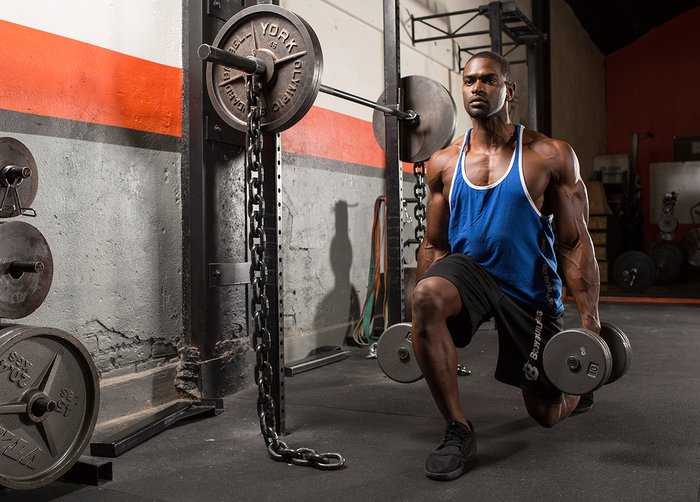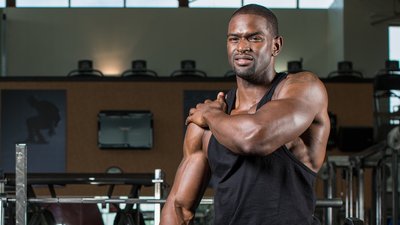For too long, the strength and conditioning world has been stuck in a matrix: the performance matrix. Many of us set our site on big round numbers, train to be able to move them for a single shaky rep, and losing sight of the price we--or our clients--pay.
People ask this constantly, so I'll ask it, too: Why do you lift? Part of your motivation is probably to live a long, healthy life. Unfortunately, getting brutally strong doesn't always result in long-term health. Sometimes, it can not only cause a void in health and wellness, but leave a gaping hole in non-task-specific performances, too—in other words, everything that's not the "big three."

If you're not a competitive athlete or lifter, I've got news for you: You fall into the "recreational lifter" category by default. Chasing strength PRs is a cool hobby, and it's also a necessary tool for progression, but if you've been lifting for a while, it definitely does beg a question that many are too ego-happy to ask.
How strong is strong enough? So let's ask it.
When Getting Strong Leaves You Weak
To be clear, I'm not telling you to avoid doing hard work, making gains, and getting strong. But at the same time, I can't shake the conviction that being able to squat 700 pounds probably doesn't outweigh the benefits of being able to squat 500 pounds. That point of diminishing returns might even be far smaller than that for you. But after a certain point, the real-world application of having this much movement-specific strength starts to diminish pretty quickly.
Chasing elite performance that competitors use to gauge their chances of stacking up against the opposition can become entrenched in the mind of a recreational lifter, but guess what? Competitors don't have your life. They typically have a small army of coaches, nutritionists, and bodyworkers supporting them. And even then, they might still struggle to play with their kids without pain. Is that really what you want to try to live up to?
Yes, numbers are fun, and they're important. But it's a sign of a truly critical thinker when he or she realizes that lifting more isn't the only means of progression. In some cases, it's doing more harm than good.
Stop Doing Heavy Assistance Exercises!
Just to be clear, this isn't just about 1RM-chasing on big lifts. One of my biggest pet peeves in the gym is when I see someone doing Peterson step-ups, face pulls, chest flyes, or rear leg-elevated split squats with a stack of weight.
If, for some reason, movements like these are the hub of your training and are your “main lifts," then have at it and load up. But for 90 percent of lifters, they're assistance movements that zero in on weak links and improve the performance of the big primal lift that they correspond to. A movement that's intended to groove patterning, isolate trouble spots, and possibly create a good pump in the process shouldn't be done for low reps and high loads.
Range of motion and other markers of rep quality go out the window while trying to deliver such a neural output, and in my eyes, the lifter is exposed as someone who is ego-driven rather than truly interested in improving his or her development.

As a lifter and coach, I've achieved great results chasing reps with lower weight in the following movements:
- Split squat or rear-leg-elevated split squat
- Walking lunge
- Dumbbell bench press
- Face pull
- Single-leg deadlift
- Peterson step-up
- Any single-arm press variation
To a point, building up to going somewhat heavy on these moves can carry over to big lifts. But in my experience with recreational lifters, I've seen limited added value from having a 300-pound single-leg deadlift or rear-leg-elevated split squat, at least as it correlates to the bilateral version of the lift.
Strength That Lasts More Than One Rep
I'll never argue with a guy who benches 600-800 when it comes to training for a greater absolute max. But I'll wager that the "shelf life" of a lifter who can push that much weight is almost always significantly shorter than that of a lifter who lifts with an eye toward sustainability. The guy with the 2000-pound total may have a higher lifetime PR and Wilks score, but the chances are good that he'll only be moving those kinds of numbers for maybe 10-15 years, tops. And when he stops, he may have more lifting injuries and chronic pain than records to show for it.
Personally, that's where the guy who decides to bench no more than 385 (to pick a random but totally impressive number) gets the win in my books. I'd rather be able to push or pull four plates for 50 years and live relatively pain-free than move eight plates for 10 years and endure pain permanently afterward.
What does this mean in action? Once you've built enough strength to establish your muscles, tendons, ligaments, and bones as legitimately strong and healthy, you can implement simple rep tweaks to make your top weight feel heavier, and back off from constantly chasing new maxes. From where I stand, it speaks more for someone's strength when they can control and manipulate submaximal loads. A haphazard 1RM max squat is far less impressive than being able to slowly control 85 percent of that load while pausing at the bottom using good form.
But here's the real kicker: After spending some time training with these sorts of submaximal intensity-boosting methods, you may be pleasantly surprised the next time you do decide to test your max.
Size Training Doesn't Always Demand Heavy Weights
Don't get me wrong: If you want to build muscle, you'll have to challenge that muscle with relatively heavy resistance at some point. But in most instances, hypertrophy is going to have more to do with your muscles' fatigue levels and the cumulative weight lifted.
It's also worthwhile to note that muscle-fiber distribution will vary not just among individuals, but among muscles as well. Certain muscle groups have a greater distribution of slow-twitch fibers, and others are more fast-twitch dominant. Common sense dictates that muscles responsible for prolonged contraction, like postural muscles, would respond more favorably to higher-rep work.
In many cases, advanced lifters looking to add size can benefit more from reducing rest intervals and finding the best ways to fatigue muscle tissue rather than trying to set new PRs regularly. Ask an old gym rat, and he or she will tell you quality training happens when you stray from a "how much ya bench" mindset and focus instead on the mind-muscle connection.

But on the other hand, the mind-muscle connection is much more difficult to find when you don't have much time—like the duration of a heavy 2-rep set.
Are You Strong Enough to Be Honest With Yourself?
Everybody knows the old "1-5 reps for strength, 6-12 for muscle, over 12 for endurance" model, but it doesn't tell the whole story. Doing sets of an exercise for 5 or even 7 reps is still strength training. Too often, a lifter gets stuck living on heavy doubles without recognizing that the skill he's developing is only becoming more and more specific to that particular task.
Yes, heavy doubles can make you stronger at a particular lift, but you can build strength—yes, strength—using a wide variety of rep ranges. And the more well-rounded your strength, the more you'll see it carry over to your bodily health.
Somewhere, someone said lifting 2.5 times your body weight makes you "strong." Though I completely agree that is a strong achievement, to limit the definition there overlooks several other areas where strength can be recognized, simply because those methods are unquantifiable and immeasurable. But that doesn't mean they're not important.
So the next time you knock out one lifting triumph and are eyeballing the next one over the horizon, ask yourself this question: Do you want to be in the lifting game for the long haul? If you do, then make your next choice carefully.

